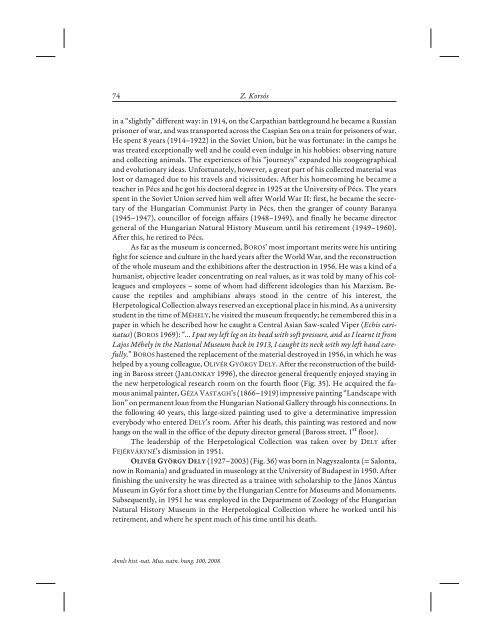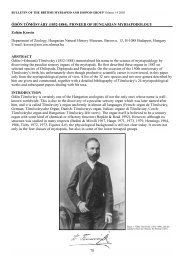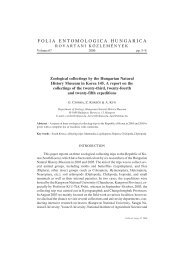History of the Herpetological Collection of the ... - Korsós Zoltán
History of the Herpetological Collection of the ... - Korsós Zoltán
History of the Herpetological Collection of the ... - Korsós Zoltán
Create successful ePaper yourself
Turn your PDF publications into a flip-book with our unique Google optimized e-Paper software.
74 Z. Korsós<br />
in a “slightly” different way: in 1914, on <strong>the</strong> Carpathian battleground he became a Russian<br />
prisoner <strong>of</strong> war, and was transported across <strong>the</strong> Caspian Sea on a train for prisoners <strong>of</strong> war.<br />
He spent 8 years (1914–1922) in <strong>the</strong> Soviet Union, but he was fortunate: in <strong>the</strong> camps he<br />
was treated exceptionally well and he could even indulge in his hobbies: observing nature<br />
and collecting animals. The experiences <strong>of</strong> his “journeys” expanded his zoogeographical<br />
and evolutionary ideas. Unfortunately, however, a great part <strong>of</strong> his collected material was<br />
lost or damaged due to his travels and vicissitudes. After his homecoming he became a<br />
teacher in Pécs and he got his doctoral degree in 1925 at <strong>the</strong> University <strong>of</strong> Pécs. The years<br />
spent in <strong>the</strong> Soviet Union served him well after World War II: first, he became <strong>the</strong> secretary<br />
<strong>of</strong> <strong>the</strong> Hungarian Communist Party in Pécs, <strong>the</strong>n <strong>the</strong> granger <strong>of</strong> county Baranya<br />
(1945–1947), councillor <strong>of</strong> foreign affairs (1948–1949), and finally he became director<br />
general <strong>of</strong> <strong>the</strong> Hungarian Natural <strong>History</strong> Museum until his retirement (1949–1960).<br />
After this, he retired to Pécs.<br />
As far as <strong>the</strong> museum is concerned, BOROS’ most important merits were his untiring<br />
fight for science and culture in <strong>the</strong> hard years after <strong>the</strong> World War, and <strong>the</strong> reconstruction<br />
<strong>of</strong> <strong>the</strong> whole museum and <strong>the</strong> exhibitions after <strong>the</strong> destruction in 1956. He was a kind <strong>of</strong> a<br />
humanist, objective leader concentrating on real values, as it was told by many <strong>of</strong> his colleagues<br />
and employees – some <strong>of</strong> whom had different ideologies than his Marxism. Because<br />
<strong>the</strong> reptiles and amphibians always stood in <strong>the</strong> centre <strong>of</strong> his interest, <strong>the</strong><br />
<strong>Herpetological</strong> <strong>Collection</strong> always reserved an exceptional place in his mind. As a university<br />
student in <strong>the</strong> time <strong>of</strong> MÉHELY, he visited <strong>the</strong> museum frequently; he remembered this in a<br />
paper in which he described how he caught a Central Asian Saw-scaled Viper (Echis carinatus)(BOROS<br />
1969): “… I put my left leg on its head with s<strong>of</strong>t pressure, and as I learnt it from<br />
Lajos Méhely in <strong>the</strong> National Museum back in 1913, I caught its neck with my left hand carefully.”BOROS<br />
hastened <strong>the</strong> replacement <strong>of</strong> <strong>the</strong> material destroyed in 1956, in which he was<br />
helped by a young colleague, OLIVÉR GYÖRGY DELY. After <strong>the</strong> reconstruction <strong>of</strong> <strong>the</strong> building<br />
in Baross street (JABLONKAY 1996), <strong>the</strong> director general frequently enjoyed staying in<br />
<strong>the</strong> new herpetological research room on <strong>the</strong> fourth floor (Fig. 35). He acquired <strong>the</strong> famous<br />
animal painter, GÉZA VASTAGH’s (1866–1919) impressive painting “Landscape with<br />
lion” on permanent loan from <strong>the</strong> Hungarian National Gallery through his connections. In<br />
<strong>the</strong> following 40 years, this large-sized painting used to give a determinative impression<br />
everybody who entered DELY’s room. After his death, this painting was restored and now<br />
hangs on <strong>the</strong> wall in <strong>the</strong> <strong>of</strong>fice <strong>of</strong> <strong>the</strong> deputy director general (Baross street, 1 st floor).<br />
The leadership <strong>of</strong> <strong>the</strong> <strong>Herpetological</strong> <strong>Collection</strong> was taken over by DELY after<br />
FEJÉRVÁRYNÉ’s dismission in 1951.<br />
(1927–2003) (Fig. 36) was born in Nagyszalonta (= Salonta,<br />
now in Romania) and graduated in museology at <strong>the</strong> University <strong>of</strong> Budapest in 1950. After<br />
finishing <strong>the</strong> university he was directed as a trainee with scholarship to <strong>the</strong> János Xántus<br />
Museum in Gyõr for a short time by <strong>the</strong> Hungarian Centre for Museums and Monuments.<br />
Subsequently, in 1951 he was employed in <strong>the</strong> Department <strong>of</strong> Zoology <strong>of</strong> <strong>the</strong> Hungarian<br />
Natural <strong>History</strong> Museum in <strong>the</strong> <strong>Herpetological</strong> <strong>Collection</strong> where he worked until his<br />
retirement, and where he spent much <strong>of</strong> his time until his death.<br />
Annls hist.-nat. Mus. natn. hung. 100, 2008




